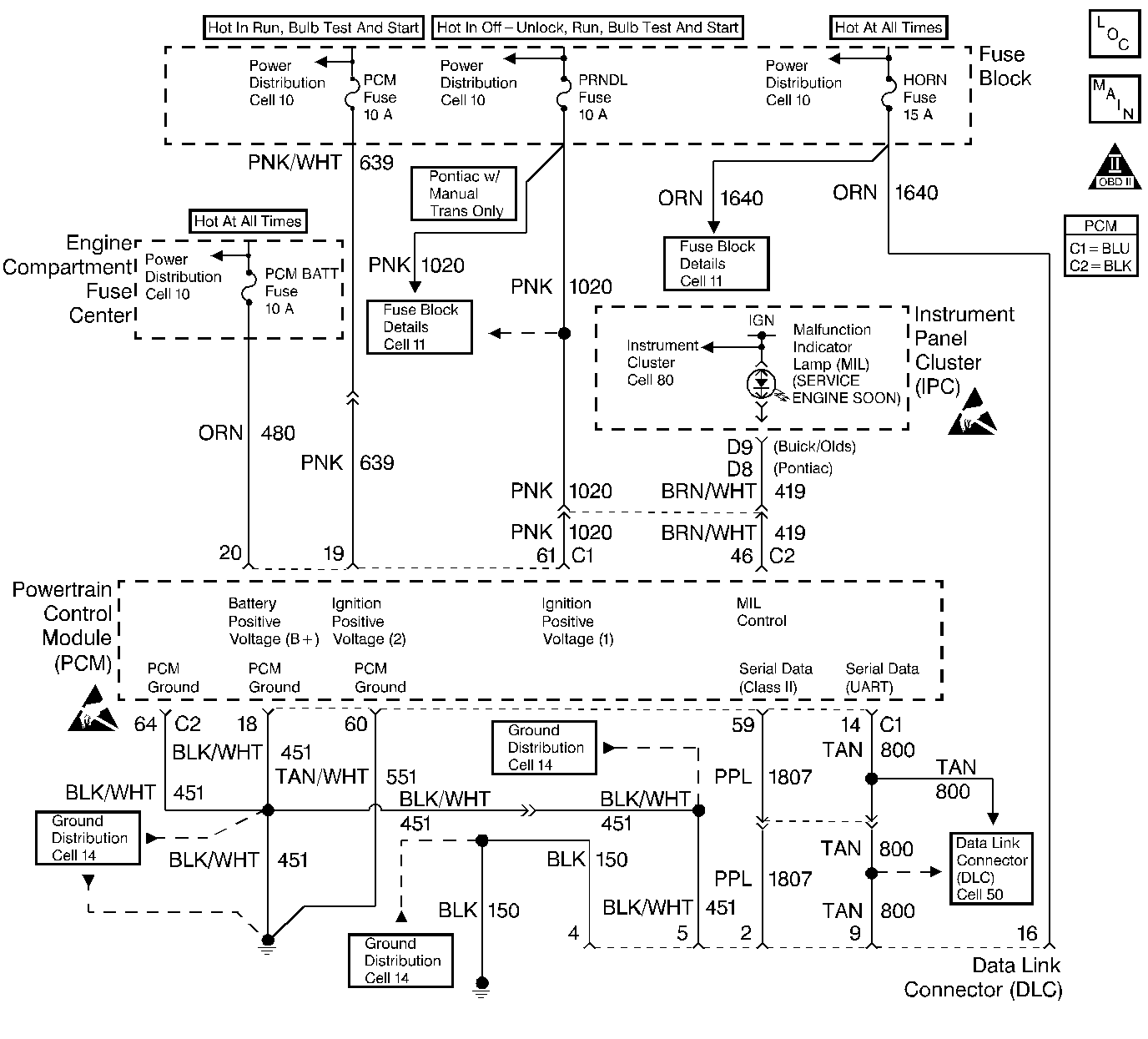
Circuit Description
The provision for communicating with the control module is the data link connector (DLC). It is usually located under the instrument panel. The DLC is used to connect to a scan tool. Some common uses of the scan tool are listed below:
| • | Identifying stored diagnostic trouble codes (DTCs). |
| • | Clearing DTCs. |
| • | Performing output control tests. |
| • | Reading serial data. |
Battery power and ground is supplied for the scan tool through the DLC. The class 2 serial data circuit to the DLC allows the PCM to communicate with the scan tool. A UART serial data line is used to communicate with other modules such as the electronic brake control module (EBCM), the supplemental inflatable restraint (SIR) system, and the instrument panel cluster (IPC).
Diagnostic Aids
Ensure that the correct application--the model year, the car line, and the VIN code--has been selected on the scan tool. If communication still cannot be established, try the scan tool on another vehicle to ensure that the scan tool or the cables are not the cause of the condition.
An intermittent may be caused by the following:
| • | Poor connection |
| • | Rubbed-through wire insulation |
| • | Broken wire inside the insulation |
Any circuitry that is suspected of causing an intermittent complaint should be thoroughly checked for the following conditions:
| • | Backed-out terminals |
| • | Improper mating of terminals |
| • | Broken locks |
| • | Improperly formed or damaged terminals |
| • | Poor terminal-to-wiring connections |
| • | Physical damage to the wiring harness |
| • | Corrosion |
Test Description
Number(s) below refer to the step number(s) on the Diagnostic Table.
-
If the scan tool requires an external power supply, check the external supply for proper voltage and ground as well as the voltage and ground supplies in the DLC.
-
Unlike the UART serial data circuit, the only time the Class 2 serial data circuit has any voltage on it is when a scan tool ask the PCM for information and the PCM sends the information out.
-
Locate and repair any shorts that may have caused the fuse to open before replacement, if the no voltage condition was due to a open fuse.
-
Replacement PCMs must be reprogrammed and the crankshaft position system variation procedure must be performed. Refer to the latest Techline information for PCM programming and Powertrain Control Module (PCM) for the Crankshaft Position System Variation Procedure.
-
Refer to Diagnostic Aids if the scan tool will not display scan data. If the scan tool can communicate with the PCM and you were sent here from thePowertrain OBD System Check table, return to that table and complete the diagnostics there.
-
The scan tool, VIM or associated cables could be malfunctioning. Refer to the scan tools manual for repair information.
Step | Action | Value(s) | Yes | No |
|---|---|---|---|---|
1 | Was the Powertrain On-Board Diagnostic (OBD) System Check performed? | -- | ||
Important: If the scan tool uses an external power supply, refer to the test description. Does the scan tool power up? | -- | |||
Does the test light remain OFF? | 2 | |||
4 | With the test light connected to ground, probe the specified DLC battery feed circuit terminal. Does the test light illuminate? | 16 | ||
5 | With a test light connected to B+, probe the specified Class 2 serial data terminal at the DLC. Does the test light remain OFF? | 2 | ||
6 | Check the Class 2 serial data circuit for a short to voltage and repair as necessary. Was a repair necessary? | -- | ||
7 | With the test light connected to B+, probe the specified DLC ground circuit terminal. Does the test light illuminate for both circuits? | 4, 5 | ||
Repair the open or short to ground in the DLC battery feed circuit. Is the action complete? | -- | -- | ||
9 | Check the Class 2 serial data circuit for an open or a poor connection and repair as necessary. Was a repair necessary? | -- | ||
10 | Check the Class 2 serial data circuit for a short to ground and repair as necessary. Was a repair necessary? | -- | ||
Replace the PCM. Is the action complete? | -- | -- | ||
12 | Repair the open or poor connection(s) in the DLC ground circuit(s). Is the action complete? | -- | -- | |
Reinstall the scan tool. Can the scan tool communicate with the PCM? | -- | |||
14 | Install the scan tool on a another vehicle with Class 2 serial data and check for proper operation. Does the scan tool work properly on a different vehicle? | -- | ||
15 | Check the DLC electrical terminals for proper tension or excessive resistance and repair as necessary. Was a repair necessary? | -- | ||
Is the action complete? | -- | -- | ||
17 |
Does the engine start and continue to run? | -- | ||
18 |
Are any DTCs displayed that have not been diagnosed? | -- | Go to Applicable DTC table | System OK |
